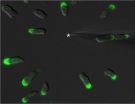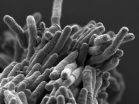(Press-News.org) July 6, 2015, Shenzhen, China-- Mitochondrial genome (mitogenome) database demonstrated its great value on detecting wild bees in UK farms via mitochondrial metagenomics pipeline, a new approach developed by scientists from the China National Genebank (CNGB), BGI-Shenzhen.
The study published today in the journal Methods in Ecology and Evolution shows that, with mitogenome references, collecting wild bees, extracting their mixed DNA, and directly reading the DNA of the resultant 'bee soup' could finally make large-scale bee monitoring programmes feasible. This new research demonstrates how the process could become quicker, cheaper and more accurate.
The approach used in the study would allow conservationists to detect where and when bee species are being lost, and importantly, whether conservation interventions are making effect.
Wild bees play a key role in pollinating wild plants and cultivated crops - maintaining both biodiversity and food production. They are however threatened by habitat loss, pesticides, climate change and disease. Safeguarding wild bee populations and their pollination services is therefore a top priority.
The UK's National Pollinator Strategy plans a large-scale bee monitoring programme. Traditional monitoring involves pinning individual bees and identifying them under a microscope. But the number of bees needed to track populations reliably over the whole country makes traditional methods infeasible. Developing an efficient long-term monitoring programme to better understand the causes of their decline is one of the goals of DEFRA's National Pollinator Strategy. This will involve a massive collection of bees across the UK. Traditionally they would be pinned and identified under a microscope, but this is so labour-intensive and error-prone that the resulting data might not be available for years after the collections.
Prof. Douglas Yu, from University of East Anglia, UK and Kunming Institute of Zoology and Dr. Xin Zhou's group from the CNGB lead the research team to apply the mitochondrial metagenomics pipeline on bulk bee samples collected in the studied regions, which have been morphologically identified by scientists from University of Reading in the UK. Dr. Zhou's group firstly conducted biodiversity study using a PCR-free method in 2013 (Zhou et al. 2013), avoided PCR-bias and demonstrated the positive correlation between biomass and the sequence numbers. Mitogenomes are expanded DNA markers beyond the conventional DNA barcodes, providing >20X of informative references for species diagnosis, which would benefit not only researches on biodiversity and ecology but also phylogenetic and evolution studies. Last year, the CNGB initiated the MT10K (10,000 mitochondrion genome, https://www.mt10k.org) project, and developed a high-throughput and cost-efficient mitogenome construction pipeline (Tang et al. 2014). The successful application of mitochondrial metagenomics pipeline on the new beestudy is very encouraging, implicating promising applications on large-scale and long-term conservation projects.
In the pipeline, mitogenome references were built first under efficient time and cost, and then the raw DNA reads from the 'bee soup' were mapped against mitogenome references. The process did not require taxonomic experts and the result was proved to be more accurate. Also, by skipping the DNA-amplification step known as PCR, the method was able to estimate the biomass contributed by each species, which makes it applicable to tracking population trajectories.
"We're trying to speed up ecological investigation on a monumental scale." said the lead researchers.
INFORMATION:
References:
Tang, M., Hardman, C. J., Ji, Y., Meng, G., Liu, S., Tan, M., Yang, S., Moss, E. D., Wang, J., Yang, C., Bruce, C., Nevard, T., Potts, S. G., Zhou, X. & Yu, D. W. (2015). High-throughput monitoring of wild bee diversity and abundance via mitogenomics. Methods in Ecology and Evolution.
Zhou, X., Li, Y., Liu, S., Yang, Q., Su, X., Zhou, L., Tang, M., Fu, R., Li, J. & Huang, Q. (2013). Ultra-deep sequencing enables high-fidelity recovery of biodiversity for bulk arthropod samples without PCR amplification. GigaScience, 2, 4.
Tang, M., Tan, M., Meng, G., Yang, S., Su, X., Liu, S., Song, W., Li, Y., Wu, Q., Zhang, A. & Zhou, X. (2014). Multiplex sequencing of pooled mitochondrial genomes-a crucial step toward biodiversity analysis using mito-metagenomics. Nucleic Acids Research, 42, e166-e166.
Chicago (July 7, 2015)- Switzerland has a long history of trying to be as self-sufficient and energy independent as possible. Although its energy supply system has served it well in the past, the country is now looking to turn away from its reliance on nuclear power and seeks to compensate for the energy lost from hydropower as a result of climate change. In the latest issue of the Bulletin of the Atomic Scientists, published by SAGE, Dominic Notter of Empa discusses how the country aims to address this transition, finding a new supply mix that combines energy conservation, ...
Scientists at the University of California, Davis, have identified a key mechanism in neuropathic pain. The discovery could eventually benefit millions of patients with chronic pain from trauma, diabetes, shingles, multiple sclerosis or other conditions that cause nerve damage.
A biological process called endoplasmic reticulum stress, or ER stress, is the significant driver of neuropathic pain, said lead researchers Bora Inceoglu of the UC Davis Department of Entomology and Nematology and UC Davis Comprehensive Cancer Center, and Ahmed Bettaieb, Department of Nutrition. ...
LOS ANGELES (July 6, 2015) - Cedars-Sinai researchers have successfully tested two new methods for preserving cognition in laboratory mice that exhibit features of Alzheimer's disease by using white blood cells from bone marrow and a drug for multiple sclerosis to control immune response in the brain.
Under the two approaches, immune cells from outside the brain were found to travel in greater numbers through the blood into the brain. The study showed measurable benefits in mice, an encouraging step toward further testing of these potentially powerful strategies in human ...
New research suggests guidelines on children's exposure to radio frequency waves from technology are confusing for parents.
The review into the polices of 34 countries, carried out by Dr Mary Redmayne, from the Department of Epidemiology and Preventive Medicine at Monash University, found varying degrees of advice about children's exposure to radio frequency electromagnetic fields (RF-EMF).
RF-EMFs are emitted from technology including WiFi, tablets and mobile phones. Associated with an increased risk of some brain tumours in heavy and long-term phone users, RF-EMFs ...
ARLINGTON HEIGHTS, Ill. (July 7, 2015) - Parents of kids with severe allergies know how scary a severe allergic reaction (anaphylaxis) is. New research offers clues as to why some kids can have a second, related reaction hours later - and what to do about it.
A study in the Annals of Allergy, Asthma and Immunology, the scientific publication of the American College of Allergy, Asthma and Immunology (ACAAI), examined records of 484 children seen in an emergency department (ED) for anaphylaxis. The researchers tracked whether there was a second, follow-up reaction. Delayed ...
When Greek mythology and cell biology meet, you get the protein Callipygian, recently discovered and named by researchers at The Johns Hopkins University for its role in determining which area of a cell becomes the back as it begins to move.
The findings, made in the amoeba Dictyostelium discoideum, shed light on how symmetrical, round cells become "polarized," or asymmetrical and directional. A summary of the findings was published online June 30 in the Proceedings of the National Academy of Sciences.
"Cells have to have a front and a back to migrate," says Peter ...
Scientists have discovered new ways in which the malaria parasite survives in the blood stream of its victims, a discovery that could pave the way to new treatments for the disease.
The researchers at the Medical Research Council's (MRC) Toxicology Unit based at the University of Leicester and the London School of Hygiene & Tropical Medicine identified a key protein, called a protein kinase, that if targeted stops the disease. The study is published today (Tuesday) in Nature Communications.
Malaria is caused by a parasite that lives inside an infected mosquito and ...
Testing thousands of approved drugs, EPFL scientists have identified an unlikely anti-tuberculosis drug: the over-the-counter antacid lansoprazole (Prevacid®).
Tuberculosis continues to be a global pandemic, second only to AIDS as the greatest single-agent killer in the world. In 2013 alone, the TB bug Mycobacterium tuberculosis caused 1.5 million deaths and almost nine million new infections. Resistance to TB drugs is widespread, creating an urgent need for new medicines. EPFL scientists have now identified lansoprazole, a widely used, over-the-counter antacid, as ...
New research from the University of Copenhagen and Herlev and Gentofte Hospital shows that high vitamin C concentrations in the blood from the intake of fruit and vegetables are associated with a reduced risk of cardiovascular disease and early death.
Fruit and vegetables are healthy. We all know that. And now there is yet another good reason for eating lots of it. New research from the University of Copenhagen shows that the risk of cardiovascular disease and early death falls with a high intake of fruit and vegetables, and that this may be dued to vitamin C.
The ...
CHARLOTTESVILLE, VA (JULY 7, 2015). Researchers at Brown University examined three magnetically programmable shunt valves to see if the magnetic field emissions of headphones can cause unintentional changes in shunt valve settings. Based on their findings, the researchers state that it is highly unlikely that commercially available headphones will interfere with programmable shunt valve settings. Full details of this study can be found in "Programmable shunts and headphones: Are they safe together?" by Heather S. Spader, MD, and colleagues, published today online, ahead ...

